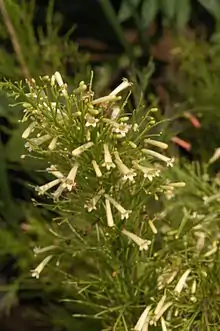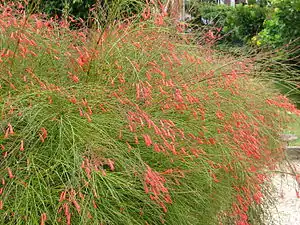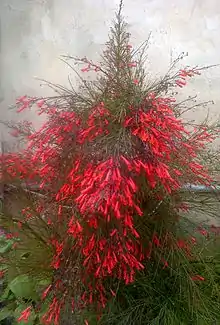Russelia equisetiformis
Russelia equisetiformis, commonly known as fountainbush,[1] firecracker plant, coral plant, coral fountain, coralblow and fountain plant, is a weeping subshrub in the family Plantaginaceae.
| Russelia equisetiformis | |
|---|---|
 | |
| Scientific classification | |
| Kingdom: | Plantae |
| Clade: | Tracheophytes |
| Clade: | Angiosperms |
| Clade: | Eudicots |
| Clade: | Asterids |
| Order: | Lamiales |
| Family: | Plantaginaceae |
| Genus: | Russelia |
| Species: | R. equisetiformis |
| Binomial name | |
| Russelia equisetiformis Schlecht. & Cham. | |
| Synonyms | |
| |
The plant is native to Mexico and Guatemala.[2]
The name Russelia honors the Scottish naturalist Alexander Russell (1715-1768), given to the genus by the Dutch scientist Baron Nikolaus von Jacquin (1727-1817). The species name reference to this plants resemblance to horse tail rushes, and the Latin term equisetiformis means "like Equisetum."
Description


Russelia equisetiformis is a multi-branching plant with 4–5 feet (1.2–1.5 m) long arching branches.[2] The overall graceful form of the subshrub is a fountainesque mound.
The stems and tiny oval leaves are bright green.
It flowers profusely with small decumbent red flowers. It can bloom year round in tropical and subtropical climates.[2]
It is a very popular nectar plant for hummingbirds and butterflies.

Cultivation
Russelia equisetiformis is cultivated as an ornamental plant, for use planted in temperate climate gardens, and in window boxes, pots, and hanging planters.[2] There are also cultivars with ivory white or pink flowers. Flowering is best in a minimum of half day sun, though the plant grows well in deep shade to bright sun.
The plant can be espaliered on a trellis for vertical display or a balcony—terrace screen (in pot). It can withstand temperatures down to −6 °C (21 °F). However some authorities assert that it cannot tolerate temperatures below 5 °C (41 °F) and must therefore be kept under glass during the winter months.[3] In colder climates it can overwinter as a houseplant in bright locations.[2]
In cultivation in the UK, It has gained the Royal Horticultural Society’s Award of Garden Merit.[3][4]
References
- "Russelia equisetiformis". Natural Resources Conservation Service PLANTS Database. USDA. Retrieved 26 October 2015.
- San Marcos Growers horticultural database: Russelia equisetiformis . accessed 12.18.2013
- "RHS Plantfinder - Russelia equisetiformis". Retrieved 11 October 2018.
- "AGM Plants - Ornamental" (PDF). Royal Horticultural Society. July 2017. p. 93. Retrieved 11 October 2018.
External links
| Wikimedia Commons has media related to Russelia equisetiformis. |